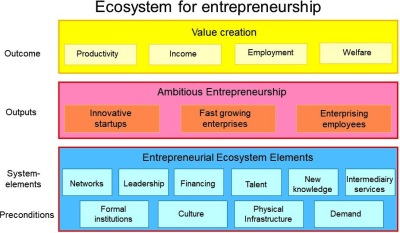STIMULATING AMBITIOUS ENTREPRENEURSHIP
CREATING VALUE BY STIMULATING INNOVATORS
Innovation and renewal have during recent decades become the engine of economic growth. Governments and authorities on European, national, and local level strongly attempt to stimulate innovative entrepreneurship.
The ecosystem approach (see the scheme to the right) gives us a language for the diagnoses of strengths and weaknesses of the socio-economic structure of a region with the purpose to arrive at targeted policy interventions, aimed at raising the welfare in the region. This can be done by the creation of institutional entities and by targeted programs and subsidies for stimulating innovators.
Through these programs and subsidies a 'market' has emerged for coaching startup-entrepreneurs, and the involved parties tend to call it an 'innovation ecosystem'.
But quite often, the 'ecosystem' includes the institutions and suppliers of intermediary services, while the parties that have to deliver value creation, the individual innovators and their startup and scale-up companies, seldom are 'member' of the ecosystem.
Because more than 95% of the new organisations fail, mostly during the transition to the scale-up phase, we have, together with some regional influencers, studied the reasons why, and what can be done about it, and how an ecosystem of the real innovators (the parties we expect to create value) can be realised.
The Bluefinger Innovation Center has, together with a number of important influencers in the Zwolle region. studied this phenomenon. We asked ourselves: How come do they fail so often? And what can we do to make them succeed more often? And how can we build a real ecosystem of innovators?
In a report about the situation in the Zwolle region year 2022, some of the institutions in the 'blue layer'*) (in Grande Plan phase 1) sketched the efforts of the parties that delivered the subsidised services (red balloons in the picture to the left).
The analyses show a large number of different parties that coached the ambitious entrepreneurs in the 'pink layer'. But how much 'value creation in the 'yellow layer' came of out this can be questioned. In any case we saw many attempts to scale-up startup companies fail desperately.
*) The 'blue, pink and yellow layer' refer to the coulours in the picture above (ecosystem for entrepreneurship); The red balloons scheme above is actually a kind of representation of parties in the blue layer, sponsored institutes in the Zwolle-region.
Most institutions had 'their own tiny garden' of coached startup companies, but no one had insight in the total amount of innovative power in the region and there was hardly any co-operation 'over the borders' of the different institutes.
The so called 'ecosystem' mentioned in Grande Plan phase 1 consisted solely of the parties in the 'blue layer/balloon scheme' and coaching mostly took place of 'starting startups' while successful startups, that even had been nominated for prices for their contribution a year before, ended up failing dramatically after having tried to accelerate.





